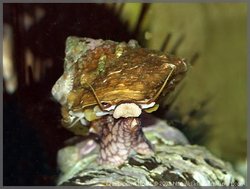Snail
|
|
| Snails | ||||||||
|---|---|---|---|---|---|---|---|---|
| Scientific classification | ||||||||
|
The name snail applies to most members of the molluscan class Gastropoda that have coiled shells. Other gastropods, which lack a conspicuous shell, are commonly called slugs, and are scattered throughout groups that primarily include snails. Snails are found in freshwater, marine, and terrestrial environments. While most people are familiar with only terrestrial snails, the majority of snails are not terrestrial. Snails with lungs belong to the group Pulmonata, while those with gills belong to the Paraphyletic group.
| Contents |
Habitat
As one of the largest classes of animals, snails can be found throughout the world. They are found in freshwater, marine, and terrestrial environments. The majority of the world's snails live in the oceans and new species are being discovered regularly. Terrestrial snails prefer damp areas around vegetation which they can use for cover during the day.
Diet
A snail's diet varies by species. Terrestrial snails such as garden snails generally eat young plant shoots or bark, or decaying vegetative matter. Carnivorous snails, such as the Decollate Snail feed on other snails. Snails eat by using their radula, or scraping tongue, to shear their food.
Reproduction
Snails, like many worms, are hermaphrodites, producing both sperm and eggs. Prolific breeders, snails exchange sperm with one another to fertilize their eggs. Each brood may consist of up to 100 eggs.
Garden snails bury their eggs in shallow topsoil primarily while the weather is warm and damp. After 2 to 4 weeks of favorable weather, these eggs hatch and the young emerge. Snails may lay eggs as often as once a month.
Predators
Snails have many natural predators, including ground beetles, snakes, toads, turtles, and birds like chickens, ducks and geese.
Snails are widely used as human food (often known as escargot) in Europe, Asia and Africa. Two species commonly eaten in Europe are the Burgundy snail (Helix pomatia) and the brown garden snail (Helix aspersa) also known as the European brown snail.
Control (Garden Pests)
Terrestrial snails and slugs are generally both migratory and nocturnal, thus difficult to control. Common methods of control include shallow dishes filled with beer, and the use of molluscicides.
Snails as Food
In French cuisine, snails are known as escargot, normally eaten seasoned with salt and pepper only. Snails are also popular in Portugal, where they are called "caracquot; (Portuguese for "snails"), and served in cheap snack houses and taverns, usually boiled with garlic. Template:AnimalClipart marine
External links
- Snail eating (http://creatures.ifas.ufl.edu/misc/gastro/snail_eating_snails.htm)
- Brown garden snail (http://creatures.ifas.ufl.edu/misc/gastro/brown_garden_snail.htm)
- Molluscs (http://animaldiversity.ummz.umich.edu/site/accounts/information/Mollusca.html)
- Kiddyhouse.com page on snails (http://www.kiddyhouse.com/Snails/snail.html)
- The trail of the snail (http://www.arnobrosi.com/snail.html)
- AppleSnail.Net (http://www.applesnail.net/)


